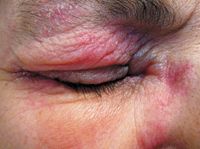- Case-Based Roundtable
- General Dermatology
- Eczema
- Chronic Hand Eczema
- Alopecia
- Aesthetics
- Vitiligo
- COVID-19
- Actinic Keratosis
- Precision Medicine and Biologics
- Rare Disease
- Wound Care
- Rosacea
- Psoriasis
- Psoriatic Arthritis
- Atopic Dermatitis
- Melasma
- NP and PA
- Skin Cancer
- Hidradenitis Suppurativa
- Drug Watch
- Pigmentary Disorders
- Acne
- Pediatric Dermatology
- Practice Management
- Prurigo Nodularis
- Buy-and-Bill
Article
Rheumatic skin diseases
Washington - Because many skin diseases have associated rheumatic components, thorough musculoskeletal evaluations can help doctors slow or prevent some patients' disability, an expert says.

"Patients with cutaneous disease often have coupled musculoskeletal disease that, although subtle at presentation, can be progressive and debilitating," says Amit Garg, M.D., assistant professor of medicine (dermatology) and director of the Rheumatic Skin Disease Clinic at University of Massachusetts Medical School.

Early detection, better symptom relief
PSA is among the most common rheumatic disorders, according to Dr. Garg.
"We have learned that inflammatory arthritis can exist as part of a complex with psoriasis. Up to about one-third of psoriasis patients develop inflammation of their joints, ligaments and tendons," he says.
In treating such patients Dr. Garg says it's not just a matter of detecting these problems, but doing so in a timely manner.
"Often enough," he adds, "the arthritis component can be aggressive and eventually debilitating. Early detection not only provides the opportunity for relief of symptoms, but it also slows or prevents long-term disability."
While NSAIDs and methotrexate merely calm joint inflammation and relieve pain, Dr. Garg says, data suggests that newer biologic drugs also address joint destruction. However, since various forms of arthritis may be present alongside psoriasis, he says it's important to distinguish between PSA and other arthritis, such as osteoarthritis, rheumatoid arthritis (RA) or gout.
To help dermatologists make such distinctions, he says the new classification of psoriatic arthritis (CASPAR) criteria may prove valid in both research and clinical settings. In a patient with inflammatory articular disease, the diagnosis of psoriatic arthritis may be established through the presence of current psoriasis, a personal or family history of psoriasis, dactylitis, characteristic nail abnormalities, seronegativity for rheumatoid factor, and the presence of periostitis on X-ray. Additionally, he says that demographics alone can provide a framework that permits clinicians to capture patterns leading to formulations of relatively narrow differential diagnoses.
Lupus and scleroderma
Systemic lupus erythematosus (SLE) represents another rheumatic disease that is commonly associated with skin manifestations, Dr. Garg says.
"We see patients with facial redness that is suspicious for the acute rash of lupus, and occasionally we have difficulty distinguishing that rash from other common dermatologic problems" including rosacea, he adds. Telling these conditions apart requires one to know, for instance, that joint tenderness, swelling and morning stiffness point to lupus.
"Serologic tests such as the ANA are also helpful in confirming our suspicions," Dr. Garg says.
In joint X-rays of lupus patients, he adds, what's missing might be as important as what's present.
"For example," Dr. Garg says, "arthritis in SLE is not typically erosive" like it is in RA and PSA.





